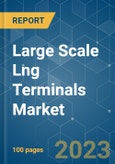The Large-Scale LNG Terminals Market is expected to record a CAGR of approximately 5% during the forecast period.
The market was negatively impacted by COVID-19. Presently the market has now reached pre-pandemic levels.
This product will be delivered within 2 business days.
The market was negatively impacted by COVID-19. Presently the market has now reached pre-pandemic levels.
Key Highlights
- Natural gas is a cleaner fuel than crude oil, helps to reduce air pollution, and thereby helps in reducing air-spread diseases that get spread through multiple toxic macro particles. On the other hand, trading takes place on the ground of requirements. The power, fertilizers, city gas distribution networks, and refineries majorly drive the liquefied natural gas market within a country.
- However, fluctuating natural gas price increases the risk associated with large-scale LNG terminal construction and, therefore, is expected to hinder the market's growth.
- The supply imbalance in the region would result in increased dependency on the other regions, which is expected to create an opportunity for the LNG terminal companies.
- The Asia-Pacific is dominating the large-scale LNG terminals market with the presence of both liquefaction and regasification terminals. Australia, Indonesia, and Malaysia have the highest capacity liquefaction terminals, while Japan, South Korea, China, and India have the highest capacity infrastructure for the regasification of LNG.
Large Scale LNG Terminals Market Trends
Regasification LNG Terminals to Dominate the Market
- In 2021, Japan, South Korea, China, and Spain dominated the market with a large capacity of LNG regasification terminals. Japan's regasification capacity for LNG accounted for 211.4 million metric tons per year in 2021, the highest in the world.
- In 2021, the total consumption of natural gas in Europe amounted to 412 billion cubic meters, up by 4% (17 billion cubic meters) compared to 2020. In 2021, the EU imported 24% of its total natural gas through LNG, with the remaining coming from pipelines, primarily from Russia, Norway, the UK, and Algeria.
- Moreover, In February 2022, 21 terminals were operating in Europe, with a combined regasification capacity of 160 bcm/year and a combined storage capacity of 7.65 million m3 LNG.
- There were five more projects (including expansion at existing terminals) under construction in Europe, adding up to an additional 19.5 bcm/year of regasification capacity overall. Thus, with the above projects and increasing LNG consumption in Europe, the LNG regasification terminals segment is expected to grow in the forecast period.
- With the increasing demand for natural gas, especially in the power sector, it is expected that more large-scale LNG is expected to get commissioned during the forecast period.
Asia-Pacific to Dominate the Market
- In 2021, According to the BP World Energy Review, the region accounted for 72% of the global capacity in LNG imports. In addition to urbanization and rapid economic growth, the construction of new LNG regasification terminals has played a key role.
- LNG imports accounted for 371.8 Billion cubic meters in Asia-Pacific in 2021. With an annual growth rate of 7.7%, imports are expected to increase in the future, which, in turn, will create demand for large-scale LNG terminals in the forecast period.
- China had 24 terminals under construction with a total capacity of 85 million tons per year. Additionally, By 2024, Singapore-based Atlantic, Gulf, and Pacific seek to open its first liquefied natural gas port in India, however, it is considering other locations in addition to the southern part of the nation as a potential site.
- Thus, with the upcoming LNG terminal projects and increasing LNG import capacity, the region is expected to dominate the market in the forecast period.
Large Scale LNG Terminals Market Competitor Analysis
The Large-Scale LNG Terminal Market is fragmented. Some of the key players in the market (not in a particular order) include TotalEnergies SE, Exxon Mobil Corporation, Shell PLC, Chevron Corporation, and BP PLC.Additional benefits of purchasing the report:
- The market estimate (ME) sheet in Excel format
- 3 months of analyst support
This product will be delivered within 2 business days.
Table of Contents
1 INTRODUCTION
4 MARKET OVERVIEW
5 MARKET SEGMENTATION
6 COMPETITIVE LANDSCAPE
Companies Mentioned (Partial List)
A selection of companies mentioned in this report includes, but is not limited to:
- Cheniere Energy Inc.
- China National Offshore Oil Corporation (CNOOC)
- TotalEnergies SE
- Exxon Mobil Corporation
- Shell PLC
- Chevron Corporation
- British Petroleum (BP) PLC
- Tokyo Electric Power Company Holding Inc.
- Tokyo Gas Co. Ltd
- Petronet LNG Ltd
Methodology

LOADING...










